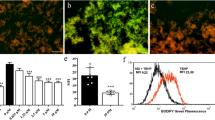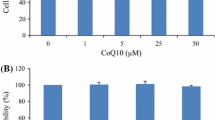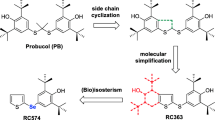Abstract
Alpha-lipoic acid (LA) has recently been reported to afford protection against neurodegenerative disorders in humans and experimental animals. However, the mechanisms underlying LA-mediated neuroprotection remain an enigma. Because peroxynitrite has been extensively implicated in the pathogenesis of various forms of neurodegenerative disorders, this study was undertaken to investigate the effects of LA in peroxynitrite-induced DNA strand breaks, a critical event leading to peroxynitrite-elicited cytotoxicity. Incubation of φX-174 plasmid DNA with the 3-morpholinosydnonimine (SIN-1), a peroxynitrite generator, led to the formation of both single- and double-stranded DNA breaks in a concentration- and time-dependent fashion. The presence of LA at 100–1,600 μM was found to significantly inhibit SIN-1-induced DNA strand breaks in a concentration-dependent manner. The consumption of oxygen induced by 250 μM SIN-1 was found to be decreased in the presence of high concentrations of LA (400–1,600 μM), indicating that LA at these concentrations may affect the generation of peroxynitrite from auto-oxidation of SIN-1. It is observed that incubation of the plasmid DNA with authentic peroxynitrite resulted in a significant formation of DNA strand breaks, which could also be dramatically inhibited by the presence of LA (100–1,600 μM). EPR spectroscopy in combination with spin-trapping experiments, using 5,5-dimethylpyrroline-N-oxide (DMPO) as spin trap, resulted in the formation of DMPO-hydroxyl radical adduct (DMPO-OH) from authentic peroxynitrite and LA at 50–1,600 μM inhibited the adduct signal. Taken together, these studies demonstrate for the first time that LA can potently inhibit peroxynitrite-mediated DNA strand breakage and hydroxyl radical formation. In view of the critical involvement of peroxynitrite in the pathogenesis of various neurodegenerative diseases, the inhibition of peroxynitrite-mediated DNA damage by LA may be responsible, at least partially, for its neuroprotective activities.





Similar content being viewed by others
Abbreviations
- DMPO:
-
5,5-dimethylpyrroline-N-oxide
- DMPO-OH:
-
DMPO-hydroxyl adduct
- DMPO-OOH:
-
DMPO-superoxide spin adduct
- EPR:
-
Electron paramagnetic resonance
- LA:
-
Alpha-lipoic acid
- PD:
-
Parkinson’s disease
- PBS:
-
Phosphate-buffer saline
- RNS:
-
Reactive nitrogen species
- ROS:
-
Reactive oxygen species
- SIN-1:
-
3-Morpholinosydnonimine
References
Leenders KL, Oertel WH (2001) Parkinson’s disease: clinical signs and symptoms, neural mechanisms, positron emission tomography, and therapeutic interventions. Neural Plast 8:99–110. doi:10.1155/NP.2001.99
Sandyk R, Bamford CR, Iacono RP (1988) Pain and sensory symptoms in Parkinson’s disease. Int J Neurosci 39:15–25. doi:10.3109/00207458808985688
Ischiropoulos H, Beckman JS (2003) Oxidative stress and nitration in neurodegeneration: cause, effect, or association? J Clin Invest 111:163–169
Floyd RA (1999) Neuroinflammatory processes are important in neurodegenerative diseases: an hypothesis to explain the increased formation of reactive oxygen and nitrogen species as major factors involved in neurodegenerative disease development. Free Radic Biol Med 26:1346–1355. doi:10.1016/S0891-5849(98)00293-7
Beckman JS, Koppenol WH (1996) Nitric oxide, superoxide, and peroxynitrite: the good, the bad, and ugly. Am J Physiol 271:C1424–C1437
Bolanos JP, Heales SJ, Land JM, Clark JB (1995) Effect of peroxynitrite on the mitochondrial respiratory chain: differential susceptibility of neurones and astrocytes in primary culture. J Neurochem 64:1965–1972
Estevez AG, Spear N, Manuel SM, Radi R, Henderson CE, Barbeito L, Beckman JS (1998) Nitric oxide and superoxide contribute to motor neuron apoptosis induced by trophic factor deprivation. J Neurosci 18:923–931
Szabo C (2003) Multiple pathways of peroxynitrite cytotoxicity. Toxicol Lett 140–141:105–112. doi:10.1016/S0378-4274(02)00507-6
Komjati K, Besson VC, Szabo C (2005) Poly (adp-ribose) polymerase inhibitors as potential therapeutic agents in stroke and neurotrauma. Curr Drug Target CNS Neurol Disord 4:179–194. doi:10.2174/1568007053544138
Cai L, Klein JB, Kang YJ (2000) Metallothionein inhibits peroxynitrite-induced DNA and lipoprotein damage. J Biol Chem 275:38957–38960. doi:10.1074/jbc.C000593200
Klotz LO, Sies H (2003) Defenses against peroxynitrite: seleno compounds and flavonoids. Toxicol Lett 140–141:125–132. doi:10.1016/S0378-4274(02)00511-8
Evans JL, Goldfine ID (2000) Alpha-lipoic acid: a multifunctional antioxidant that improves insulin sensitivity in patients with type 2 diabetes. Diabetes Technol Ther 2:401–413. doi:10.1089/15209150050194279
El Midaoui A, de Champlain J (2002) Prevention of hypertension, insulin resistance, and oxidative stress by alpha-lipoic acid. Hypertension 39:303–307. doi:10.1161/hy0202.104345
Packer L, Tritschler HJ, Wessel K (1997) Neuroprotection by the metabolic antioxidant alpha-lipoic acid. Free Radic Biol Med 22:359–378. doi:10.1016/S0891-5849(96)00269-9
Tirosh O, Sen CK, Roy S, Kobayashi MS, Packer L (1999) Neuroprotective effects of alpha-lipoic acid and its positively charged amide analogue. Free Radic Biol Med 26:1418–1426. doi:10.1016/S0891-5849(99)00014-3
Wolz P, Krieglstein J (1996) Neuroprotective effects of alpha-lipoic acid and its enantiomers demonstrated in rodent models of focal cerebral ischemia. Neuropharmacology 35:369–375. doi:10.1016/0028-3908(95)00172-7
Packer L, Roy S, Sen CK (1997) Alpha-lipoic acid: a metabolic antioxidant and potential redox modulator of transcription. Adv Pharmacol 38:79–101. doi:10.1016/S1054-3589(08)60980-1
Biewenga GP, Haenen GR, Bast A (1997) The pharmacology of the antioxidant lipoic acid. Gen Pharmacol 29:315–331. doi:10.1016/S0306-3623(96)00474-0
Moini H, Packer L, Saris NE (2002) Antioxidant and prooxidant activities of alpha-lipoic acid and dihydrolipoic acid. Toxicol Appl Pharmacol 182:84–90. doi:10.1006/taap.2002.9437
Jia Z, Hallur S, Zhu H, Li Y, Misra HP (2008) Potent upregulation of glutathione and NAD(P)H:quinone oxidoreductase 1 by alpha-lipoic acid in human neuroblastoma SH-SY5Y cells—protection against neurotoxicant-elicited cytotoxicity. Neurochem Res 33:790–800. doi:10.1007/s11064-007-9496-5
Li Y, Kuppusamy P, Zweier JL, Trush MA (1996) Role of Cu/Zn-superoxide dismutase in xenobiotic activation. I. Chemical reactions involved in the Cu/Zn-superoxide dismutase-accelerated oxidation of the benzene metabolite 1,4-hydroquinone. Mol Pharmacol 49:404–411
Jia Z, Zhu H, Trush MA, Misra HP, Li Y (2008) Generation of superoxide from reaction of 3H-1,2-dithiole-3-thione with thiols: implications for dithiolethione chemoprotection. Mol Cell Biochem 307:185–191. doi:10.1007/s11010-007-9598-z
Jia Z, Zhu H, Misra BR, Mahaney JE, Li Y, Misra HP (2008) EPR studies on the superoxide-scavenging capacity of the nutraceutical resveratrol. Mol Cell Biochem 313:187–194
Pieper GM, Felix CC, Kalyanaraman B, Turk M, Roza AM (1995) Detection by ESR of DMPO hydroxyl adduct formation from islets of langerhans. Free Radic Biol Med 19:219–225. doi:10.1016/0891-5849(95)00018-S
Li Y, Trush MA (1993) DNA damage resulting from the oxidation of hydroquinone by copper: role for a Cu(II)/Cu(I) redox cycle and reactive oxygen generation. Carcinogenesis 14:1303–1311. doi:10.1093/carcin/14.7.1303
Ruan RS (2002) Possible roles of nitric oxide in the physiology and pathophysiology of the mammalian cochlea. Ann N Y Acad Sci 962:260–274
Frejaville C, Karoui H, Tuccio B, Le Moigne F, Culcasi M, Pietri S, Lauricella R, Tordo P (1995) 5-(Diethoxyphosphoryl)-5-methyl-1-pyrroline N-oxide: a new efficient phosphorylated nitrone for the in vitro and in vivo spin trapping of oxygen-centered radicals. J Med Chem 38:258–265. doi:10.1021/jm00002a007
Stolze K, Udilova N, Nohl H (2000) Spin trapping of lipid radicals with DEPMPO-derived spin traps: detection of superoxide, alkyl and alkoxyl radicals in aqueous and lipid phase. Free Radic Biol Med 29:1005–1014. doi:10.1016/S0891-5849(00)00401-9
Zang LY, Misra HP (1992) EPR kinetic studies of superoxide radicals generated during the autooxidation of 1-methyl-4-phenyl-2,3-dihydropyridinium, a bioactivated intermediate of parkinsonian-inducing neurotoxin 1-methyl-4-phenyl-1,2,3,6-tetrahydropyridine. J Biol Chem 267:23601–23608
Ebadi M, Sharma SK (2003) Peroxynitrite and mitochondrial dysfunction in the pathogenesis of Parkinson’s disease. Antioxid Redox Signal 5:319–335. doi:10.1089/152308603322110896
Torreilles F, Salman-Tabcheh S, Guerin M, Torreilles J (1999) Neurodegenerative disorders: the role of peroxynitrite. Brain Res Brain Res Rev 30:153–163. doi:10.1016/S0165-0173(99)00014-4
Virag L, Szabo E, Gergely P, Szabo C (2003) Peroxynitrite-induced cytotoxicity: mechanism and opportunities for intervention. Toxicol Lett 140–141:113–124. doi:10.1016/S0378-4274(02)00508-8
Cao Z, Li Y (2004) Potent inhibition of peroxynitrite-induced DNA strand breakage by ethanol: possible implications for ethanol-mediated cardiovascular protection. Pharmacol Res 50:13–19. doi:10.1016/j.phrs.2003.12.010
Teichert J, Kern J, Tritschler HJ, Ulrich H, Preiss R (1998) Investigations on the pharmacokinetics of alpha-lipoic acid in healthy volunteers. Int J Clin Pharmacol Ther 36:625–628
Dicter N, Madar Z, Tirosh O (2002) Alpha-lipoic acid inhibits glycogen synthesis in rat soleus muscle via its oxidative activity and the uncoupling of mitochondria. J Nutr 132:3001–3006
Bian ZY, Guo XQ, Zhao YB, Du JO (2005) Probing the hydroxyl radical-mediated reactivity of peroxynitrite by a spin-labeling fluorophore. Anal Sci 21:553–559. doi:10.2116/analsci.21.553
Packer L, Witt EH, Tritschler HJ (1995) Alpha-lipoic acid as a biological antioxidant. Free Radic Biol Med 19:227–250. doi:10.1016/0891-5849(95)00017-R
Matsugo S, Yan LJ, Han D, Trischler HJ, Packer L (1995) Elucidation of antioxidant activity of alpha-lipoic acid toward hydroxyl radical. Biochem Biophys Res Commun 208:161–167. doi:10.1006/bbrc.1995.1318
Szabo C (1998) Role of nitric oxide in endotoxic shock. An overview of recent advances. Ann N Y Acad Sci 851:422–425. doi:10.1111/j.1749-6632.1998.tb09019.x
Trujillo M, Radi R (2002) Peroxynitrite reaction with the reduced and the oxidized forms of lipoic acid: new insights into the reaction of peroxynitrite with thiols. Arch Biochem Biophys 397:91–98. doi:10.1006/abbi.2001.2619
Augusto O, Gatti RM, Radi R (1994) Spin-trapping studies of peroxynitrite decomposition and of 3-morpholinosydnonimine N-ethylcarbamide autooxidation: direct evidence for metal-independent formation of free radical intermediates. Arch Biochem Biophys 310:118–125. doi:10.1006/abbi.1994.1147
Ziegler D, Nowak H, Kempler P, Vargha P, Low PA (2004) Treatment of symptomatic diabetic polyneuropathy with the antioxidant alpha-lipoic acid: a meta-analysis. Diabet Med 21:114–121. doi:10.1111/j.1464-5491.2004.01109.x
Trujillo M, Folkes L, Bartesaghi S, Kalyanaraman B, Wardman P, Radi R (2005) Peroxynitrite-derived carbonate and nitrogen dioxide radicals readily react with lipoic and dihydrolipoic acid. Free Radic Biol Med 39:279–288. doi:10.1016/j.freeradbiomed.2005.03.014
Rezk BM, Haenen GR, van der Vijgh WJ, Bast A (2004) Lipoic acid protects efficiently only against a specific form of peroxynitrite-induced damage. J Biol Chem 279:9693–9697. doi:10.1074/jbc.M312289200
Acknowledgments
This work was supported in part by NIH grant HL71190 (Y.L.), and a grant from Harvey Peters Research Foundation (H.P.M.).
Author information
Authors and Affiliations
Corresponding authors
Rights and permissions
About this article
Cite this article
Jia, Z., Zhu, H., Vitto, M.J. et al. Alpha-lipoic acid potently inhibits peroxynitrite-mediated DNA strand breakage and hydroxyl radical formation: implications for the neuroprotective effects of alpha-lipoic acid. Mol Cell Biochem 323, 131–138 (2009). https://doi.org/10.1007/s11010-008-9971-6
Received:
Accepted:
Published:
Issue Date:
DOI: https://doi.org/10.1007/s11010-008-9971-6




